- An overview of the aquatic OOTD (Outfit of the Day) concept and its relevance in marine life presentations
- The use of aquatic OOTD in enhancing public engagement and education in zoology and conservation
- How zoo management curates aquatic OOTDs with respect to animal welfare and environmental context
- The implications for wildlife conservation through the popularization of aquatic OOTDs
- Strategies for communicating scientific information via social media trends like aquatic OOTD
Enthusiasm for the world’s oceans and the captivating creatures that reside within them has surged in recent years, largely due to innovative educational efforts by zoological institutions and wildlife conservationists. Among the more intriguing strategies is what might be known as an aquatic OOTD or “Outfit of the Day,” a play on the fashion industry’s acronym describing a stylish ensemble chosen for the day. In marine life, an aquatic OOTD does not refer to actual clothing, of course, but metaphorically represents a showcased species or a particular animal presentation designed to pique public interest and share knowledge about aquatic life.
The concept of aquatic OOTD has a key role in modern zoo management and wildlife conservation efforts. It enables institutions to focus daily attention on different species, their habits, ecologies, and conservation statuses, thereby keeping the public connected and invested in the wellbeing of aquatic life. This approach stimulates curiosity and fosters a connection between the public and marine animals, turning every showcase into an educational opportunity.
To make these presentations as informative and engaging as possible, zoo management teams carefully select and prepare the featured aquatic animals. This selection process considers the animal’s health, behavior, and suitability for public display while ensuring their welfare is not compromised. Coordination between animal care staff, educators, and marketing departments is crucial to balance the educational goals with the physical and psychological needs of the animals.
Aquatic OOTD trends have direct implications for wildlife conservation. By highlighting various species and their stories, zoos can directly promote conservation messages and encourage public support for preservation efforts. Showcasing animals that may be endangered or threatened often leads to discussions on human impacts on marine ecosystems and inspires visitors to consider how they can contribute to ocean conservation.
The rise of social media platforms has transformed how scientific information and conservation messages are conveyed to the public. Platforms like Instagram, Twitter, and Facebook have become vital tools for disseminating these messages quickly and effectively. The use of aquatic OOTD as a content strategy on these platforms dovetails perfectly with social media’s visual and engaging nature. It allows for communicating complex scientific information in a more relatable and digestible format, making science more accessible to non-specialists.
Focusing on visually striking or behaviorally interesting species aims to capture the public’s imagination and draw them into a deeper narrative about marine ecosystems and conservation needs. These posts can lead to increased awareness and concern for environmental issues. They can motivate the public to support conservation initiatives through donations, volunteering, or simply by making more informed choices in their daily lives.
Indeed, the practice of presenting aquatic OOTDs fosters a bond between humans and the marine world. As individuals scroll through their social media feeds and engage with content featuring sea turtles gliding through the water or the vibrant patterns of coral reef fish, they experience moments of awe and fascination that ignite a passion for the ocean and its inhabitants. The sheer diversity presented through aquatic OOTDs underscores the incredible variety of life forms that call the oceans home and emphasizes why it is vital to protect these environments.
The posts often include commentary from marine biologists and conservationists to add to the educational value. These experts share their insights, talking about the animals’ natural behaviors, diets, and roles in their ecosystem, thus providing a broader context and deeper understanding of the species being highlighted.
Zoos and aquariums are responsible for providing enriching environments for their marine inhabitants and presenting them to the public responsibly, without overstressing the individuals. It is important to respect and reflect the natural lives of these creatures, even while acknowledging the entertainment and engagement value they provide. Innovation in this space comes from creating experiences that are as educational as they are enthralling, ensuring that each aquatic OOTD contributes positively to the broader conservation and education goals.
Social media users often seek visually appealing and informative content, and aquatic OOTD posts achieve this. However, the ultimate success lies not just in a single engaging post but also in the ongoing conversation and activism it sparks. As these snapshots of the underwater world circulate online, they join a larger narrative of conservation and stewardship, which is crucial for the future of our planet’s blue resources.
While providing value with every post, zoological institutions need to approach each aquatic OOTD as a piece of a larger educational puzzle. The strategy behind these communications should remain focused on inspiring stewardship and demonstrating the respect and care that goes into managing aquatic life exhibits. By striking a balance between scientific accuracy and the natural allure of marine organisms, the aquatic OOTD becomes an impactful tool in promoting the conservation of underwater life and the overall health of our oceans.
Curating a captivating aquatic OOTD goes beyond capturing a stunning image; it’s about connecting people to the marine world in a way that resonates with their daily lives and encourages them to consider their part in sustaining these ecosystems. Through the strategic use of these educational snippets, the goal is to facilitate a global community that is enchanted by the wonders of aquatic life and actively dedicated to preserving it for future generations.
*****
Source Description
An aquatic OOTD.


